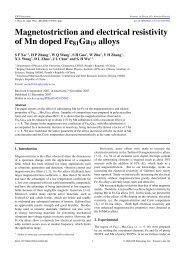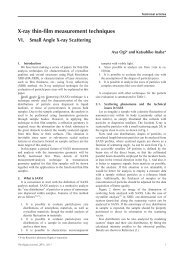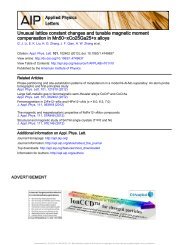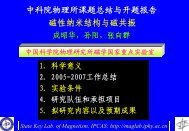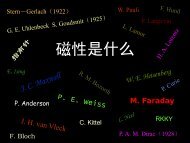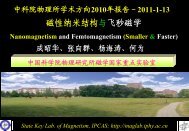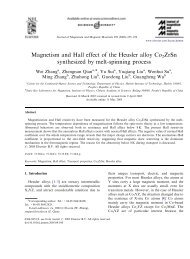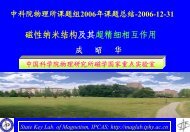Electronic structure and magnetism of the Heusler alloy Mn2NiAl A ...
Electronic structure and magnetism of the Heusler alloy Mn2NiAl A ...
Electronic structure and magnetism of the Heusler alloy Mn2NiAl A ...
You also want an ePaper? Increase the reach of your titles
YUMPU automatically turns print PDFs into web optimized ePapers that Google loves.
ARTICLE IN PRESSPhysica B 405 (2010) 3092–3095Contents lists available at ScienceDirectPhysica Bjournal homepage: www.elsevier.com/locate/physb<strong>Electronic</strong> <strong>structure</strong> <strong>and</strong> <strong>magnetism</strong> <strong>of</strong> <strong>the</strong> <strong>Heusler</strong> <strong>alloy</strong> Mn 2 NiAl: A<strong>the</strong>oretical study <strong>of</strong> <strong>the</strong> shape–memory behaviorHongzhi Luo a,b,n , Guodong Liu a , Fanbin Meng a , Shijie Li a , Wei Zhu b ,Guangheng Wu b , Xiaoxi Zhu c , Chengbao Jiang ca School <strong>of</strong> Material Science <strong>and</strong> Engineering, Hebei University <strong>of</strong> Technology, Tianjin 300130, PR Chinab Beijing National Laboratory for Condensed Matter Physics, Institute <strong>of</strong> Physics, Chinese Academy <strong>of</strong> Sciences, Beijing 100190, PR Chinac School <strong>of</strong> Material Science <strong>and</strong> Engineering, Beijing University <strong>of</strong> Aeronautics <strong>and</strong> Astronautics, Beijing 100083, PR Chinaarticle infoArticle history:Received 9 April 2010Accepted 13 April 2010Keywords:<strong>Heusler</strong> <strong>alloy</strong>B<strong>and</strong> <strong>structure</strong>Martensitic transformationabstractThe electronic <strong>structure</strong> <strong>and</strong> <strong>magnetism</strong> <strong>of</strong> <strong>the</strong> <strong>Heusler</strong> <strong>alloy</strong> Mn 2 NiAl have been studied by firstprinciplescalculations. It is found that <strong>the</strong> phase transformation from <strong>the</strong> cubic to <strong>the</strong> tetragonal<strong>structure</strong> lowers <strong>the</strong> total energy, indicating that <strong>the</strong> martensitic phase is more stable <strong>and</strong> that a phasetransition from austenite to martensite may happen at a lower temperature. Thus, ferromagnetic shapememory effect can be expected to occur in Mn 2 NiAl or in <strong>alloy</strong>s <strong>of</strong> similar composition. Mn 2 NiAl is aferrimagnet in both <strong>the</strong> austenitic <strong>and</strong> martensitic phases. The total spin moments are 1.48 <strong>and</strong> 1.14 m B /f.u.for <strong>the</strong> austenite <strong>and</strong> martensite, respectively. Because <strong>the</strong> contribution <strong>of</strong> Ni to <strong>the</strong> total moment is small,<strong>the</strong> total moment is mainly determined by <strong>the</strong> antiparallel aligned Mn(A) <strong>and</strong> Mn(B) spin moments.& 2010 Elsevier B.V. All rights reserved.1. IntroductionIn recent years, Mn-based <strong>Heusler</strong> <strong>alloy</strong>s have received muchattention because <strong>of</strong> <strong>the</strong>ir potential application as half-metallicmaterials, ferromagnetic shape–memory <strong>alloy</strong>s (FSMAs) <strong>and</strong> o<strong>the</strong>rfunctional materials. Half-metallic materials can act as a spinfilter providing a current with a high degree <strong>of</strong> spin polarization,which is <strong>of</strong> great importance in spin-dependent devices [1].Mn 2 VAl, Mn 3 Ga, <strong>and</strong> also Mn 2 CoZ (Z¼Al, Ga, Si, Sb) have beenpredicted to be half-metallic materials by <strong>the</strong>oretical <strong>and</strong>experimental studies [2–5]. Meanwhile, new FSMAs have alsobeen discovered among Mn-based <strong>Heusler</strong> <strong>alloy</strong>s [6–8]. FSMAs aremagnetic materials that exhibit a martensitic transformationtoge<strong>the</strong>r with large magnetic-field-induced strains. They canserve as magnetic actuator material.In studies <strong>of</strong> FSMA, it is found that most FSMAs among <strong>the</strong><strong>Heusler</strong> <strong>alloy</strong>s are Ni–Mn based <strong>alloy</strong>s, which can be obtained bysubstitution <strong>of</strong> some main group elements for Ni or Mn inNi 50 Mn 50 <strong>alloy</strong>s [9]. Besides experimental studies on <strong>the</strong> Ni–Mnsystem, <strong>the</strong>oretical calculations also play an important role in<strong>the</strong> search for new FSMAs. Chakrabarti <strong>and</strong> Barman [10]have predicted by first-principles calculations <strong>the</strong> martensitictransformation behavior in <strong>the</strong> stoichiometric <strong>Heusler</strong> <strong>alloy</strong>n Corresponding author at: School <strong>of</strong> Material Science <strong>and</strong> Engineering, HebeiUniversity <strong>of</strong> Technology, Tianjin 300130, P R China. Tel.: +86 22 60204765;fax: +86 22 26564129.E-mail addresses: hongzhi_luo@yahoo.com.cn, luo_hongzhi@163.com (H. Luo).Mn 2 NiIn, in which <strong>the</strong> main group element In has beensubstituted for 50% <strong>of</strong> <strong>the</strong> Ni in NiMn. Accordingly, a martensitictransformation has been observed in Mn 50 Ni 40 In 10 ribbons atabout 200 K [7]. So, to syn<strong>the</strong>size new FSMAs, <strong>the</strong>oreticalcalculations may be <strong>of</strong> essential importance.In this paper, <strong>the</strong> electronic <strong>structure</strong> <strong>and</strong> magnetic properties<strong>of</strong> <strong>the</strong> <strong>Heusler</strong> <strong>alloy</strong> Mn 2 NiAl with bcc <strong>and</strong> with tetragonal<strong>structure</strong> are studied by first-principles calculations. Thepossibility <strong>of</strong> martensitic transformation behavior in Mn 2 NiAl ispredicted.2. Computational methodsThe electronic <strong>structure</strong> has been calculated using <strong>the</strong>pseudopotential method with a plane-wave basis set based ondensity-functional <strong>the</strong>ory [11,12]. The interactions between <strong>the</strong>atomic core <strong>and</strong> <strong>the</strong> valence electrons are described by <strong>the</strong>ultras<strong>of</strong>t pseudopotential [13]. The electronic exchange-correlationenergy has been treated under <strong>the</strong> local-density approximation(LDA) [14,15]. For all cases, a plane-wave basis set cut-<strong>of</strong>f <strong>of</strong>500 eV was used <strong>and</strong> 182 k points were employed in <strong>the</strong>irreducible Brillouin zone. These parameters ensured goodconvergence <strong>of</strong> <strong>the</strong> total energy. The convergence tolerance in<strong>the</strong> calculations was selected as 1 10 6 eV/atom. The calculationswere performed based on <strong>the</strong> <strong>the</strong>oretical equilibrium latticeparameters.0921-4526/$ - see front matter & 2010 Elsevier B.V. All rights reserved.doi:10.1016/j.physb.2010.04.022
ARTICLE IN PRESSH. Luo et al. / Physica B 405 (2010) 3092–3095 30933. Results <strong>and</strong> discussion-2703.9The <strong>Heusler</strong> <strong>alloy</strong> crystallizes in a highly-ordered bcc <strong>structure</strong><strong>and</strong> has a stoichiometric composition X 2 YZ, where X <strong>and</strong> Y aretransition-metal elements, <strong>and</strong> Z is a main-group element.Generally, <strong>the</strong> <strong>Heusler</strong>-<strong>alloy</strong> <strong>structure</strong> can be looked upon as fourinterpenetrating fcc lattices, in which <strong>the</strong> transition-metal atomsoccupy <strong>the</strong> A(0, 0, 0), B 1 4 ,1 4 4 ,1 <strong>and</strong> C12 ,1 2 2 ,1 sites, respectively. Themain-group-element occupies <strong>the</strong> D 3 4 ,3 4 4 ,3 site. As an example,Fig. 1 presents <strong>the</strong> crystal <strong>structure</strong> <strong>of</strong> <strong>the</strong> <strong>Heusler</strong> <strong>alloy</strong>.According to previous studies, <strong>the</strong> site preference <strong>of</strong> <strong>the</strong> 3delements is determined by <strong>the</strong> number <strong>of</strong> <strong>the</strong>ir valence electrons.The elements with less d electrons prefer occupying <strong>the</strong> B siteswhereas elements with more electrons prefer <strong>the</strong> (A, C) sites [16].So,in <strong>the</strong> stable <strong>structure</strong> <strong>of</strong> Mn 2 NiAl, one Mn atom <strong>and</strong> one Ni atomoccupy <strong>the</strong> (A, C) sites <strong>and</strong> <strong>the</strong> o<strong>the</strong>r Mn enters <strong>the</strong> B site, leaving <strong>the</strong>D site to Al. This is called <strong>the</strong> Hg 2 CuTi-type <strong>of</strong> <strong>structure</strong> [16] as hasbeen reported for Mn 2 NiSn [17] or Mn 2 NiGa [6]. This <strong>structure</strong> isdifferent from <strong>the</strong> Cu 2 MnAl type <strong>of</strong> <strong>structure</strong>, which is usual for<strong>Heusler</strong> <strong>alloy</strong>s. In <strong>the</strong> Cu 2 MnAl type <strong>of</strong> <strong>structure</strong>, <strong>the</strong> two Mn atomsoccupy <strong>the</strong> (A, C) sites equally <strong>and</strong> leave <strong>the</strong> B site to Ni.To determine <strong>the</strong> <strong>the</strong>oretical lattice parameter, <strong>and</strong> test <strong>the</strong> sitepreference in Mn 2 NiAl, we have performed calculations onMn 2 NiAl with <strong>the</strong> Hg 2 CuTi- <strong>and</strong> with <strong>the</strong> Cu 2 MnAl-type <strong>of</strong><strong>structure</strong> in both <strong>the</strong> non-magnetic (PM) <strong>and</strong> <strong>the</strong> ferromagnetic(FM) states. The results are presented in Fig. 2. It can be seen that,in both <strong>structure</strong>s, <strong>the</strong> FM states are lower on <strong>the</strong> energy scale <strong>and</strong>thus more stable. The energy difference between <strong>the</strong> Hg 2 CuTi- <strong>and</strong><strong>the</strong> Cu 2 MnAl-type <strong>of</strong> <strong>structure</strong> is 0.92 eV, confirming <strong>the</strong> sitepreference discussed above. The equilibrium lattice constant <strong>of</strong>Mn 2 NiAl is 5.636 Å, which is a bit smaller than that <strong>of</strong> Mn 2 NiGa [6],due to <strong>the</strong> smaller atomic radius <strong>of</strong> Al compared with that <strong>of</strong> Ga.Fig. 3 presents <strong>the</strong> calculated total <strong>and</strong> partial density <strong>of</strong> states(DOS) <strong>of</strong> Mn 2 NiAl in <strong>the</strong> austenitic phase. The total DOS <strong>of</strong>Mn 2 NiAl consists <strong>of</strong> a low-energy part (below 6 eV), which ismainly made up <strong>of</strong> <strong>the</strong> s-states <strong>of</strong> Al, <strong>and</strong> a high-energy part(above 5 eV), which mainly arises from <strong>the</strong> contributions <strong>of</strong> <strong>the</strong>d-states <strong>of</strong> Mn <strong>and</strong> Ni atoms, toge<strong>the</strong>r with <strong>the</strong> p-states <strong>of</strong> Al.-2704.2-2704.5-2704.8-2705.1Mn 2 NiAlaustenite5.3 5.4 5.5 5.6 5.7 5.8 5.9Lattice constant (Å)Fig. 2. Calculated total energy for Mn 2 NiAl as a function <strong>of</strong> <strong>the</strong> lattice parametersfor both <strong>the</strong> Cu 2 MnAl- <strong>and</strong> <strong>the</strong> Hg 2 CuTi-type <strong>of</strong> <strong>structure</strong> in <strong>the</strong> non-magnetic(PM) <strong>and</strong> ferrimagnetic (FM) state.8 Mn 2 NiAlTotal0-8Austenite4 Mn (A)0-44 Mn (B)0-4Ni-2 02 2Al0-2-8 -6 -4 -2 0 2 4Energy (eV)Fig. 3. Calculated spin-projected total <strong>and</strong> partial DOS <strong>of</strong> Mn 2 NiAl in <strong>the</strong> austeniticphase.The general properties <strong>of</strong> <strong>the</strong> total DOS are dominated by Ni <strong>and</strong>Mn 3d states in <strong>the</strong> bonding <strong>and</strong> antibonding region.In both <strong>the</strong> majority- <strong>and</strong> minority-spin directions, <strong>the</strong> totalDOS is separated into bonding <strong>and</strong> antibonding states by anenergy gap below <strong>the</strong> Fermi level (E F ). The majority-spin statesshow a three-peak <strong>structure</strong>, which arises from <strong>the</strong> contributions<strong>of</strong> <strong>the</strong> spin-up bonding <strong>and</strong> antibonding states <strong>of</strong> both <strong>the</strong> Mn <strong>and</strong><strong>the</strong> Ni atoms. In <strong>the</strong> minority DOS, <strong>the</strong> states below <strong>the</strong> energygap are mainly composed <strong>of</strong> <strong>the</strong> bonding peaks <strong>of</strong> Mn (A) <strong>and</strong> Ni<strong>and</strong> <strong>the</strong> states above <strong>the</strong> gap come from <strong>the</strong> antibonding peak <strong>of</strong>Mn (B). In <strong>the</strong> majority-spin states, <strong>the</strong> energy gap is locatedaround 0.33 eV, while in <strong>the</strong> minority-spin states, <strong>the</strong> gap isshifted to 0.65 eV due to <strong>the</strong> magnetic splitting.It should be noted that, in <strong>the</strong> total DOS <strong>of</strong> austenitic Mn 2 NiAl, E F islocated at <strong>the</strong> shoulder <strong>of</strong> a DOS peak in both spin directions, resultingin a relatively high N(E F ). It has been reported that a high N(E F ) willdecrease <strong>the</strong> <strong>structure</strong> stability while low N(E F )has<strong>the</strong>oppositeeffect[18,19]. So, this may result in <strong>the</strong> possibility <strong>of</strong> a structuraltransformation with lowering temperatures. The electronic <strong>structure</strong><strong>of</strong> <strong>the</strong> martensitic phase will be discussed in <strong>the</strong> next section.In Fig. 3, <strong>the</strong> PDOS <strong>of</strong> Mn(B) shows a two-peak <strong>structure</strong> (bondingFig. 1. Crystal <strong>structure</strong> <strong>of</strong> <strong>Heusler</strong> <strong>alloy</strong>s. The unit cell has four crystal sites as <strong>the</strong> <strong>and</strong> antibonding peak) due to <strong>the</strong> crystal-field effect, which results basis: Að0,0,0Þ,B 1 in a large local spin moment at <strong>the</strong> Mn(B) site. It may be noted that,4 ,1 4 4 ,1 ,C 12 ,1 2 ,1 2 , <strong>and</strong> D 34 ,3 4 ,3 4 in Wyck<strong>of</strong>f coordinates.Energy (eV)DOS (electrons / eV)Hg 2 CuTi-type FMHg 2 CuTi-type PMCu 2 MnAl-type FMCu 2 MnAl-type PM
ARTICLE IN PRESS3094H. Luo et al. / Physica B 405 (2010) 3092–3095for Mn 2 NiAl, <strong>the</strong> <strong>structure</strong> <strong>of</strong> <strong>the</strong> PDOS <strong>of</strong> Mn(A) <strong>and</strong> Mn(B) isopposite to each o<strong>the</strong>r. In <strong>the</strong> majority states <strong>of</strong> Mn (B), <strong>the</strong> twopeaks are basically below <strong>the</strong> Fermi level <strong>and</strong> occupied <strong>and</strong>, in <strong>the</strong>minority PDOS, <strong>the</strong> antibonding peak is high above E F . In contrast,<strong>the</strong> partial DOS <strong>of</strong> Mn(A) lies mainly below E F in <strong>the</strong> minority-spinstates <strong>and</strong>, above E F , in <strong>the</strong> majority-spin states. Therefore, <strong>the</strong>contributions to <strong>the</strong> total DOS from Mn(A) <strong>and</strong> Mn(B) are opposite toeach o<strong>the</strong>r, indicating an antiparallel configuration <strong>of</strong> <strong>the</strong>ir spinmoments [4]. This agrees well with reported results on Mn 2 NiGa[10]. InMn 2 NiAl, <strong>the</strong> two Mn atoms are nearest neighbors with adistance <strong>of</strong> 1.991 Å. The small distance may cause strong direct Mn–Mn interaction <strong>and</strong> result in <strong>the</strong> antiparallel orientation <strong>of</strong> Mn (A)<strong>and</strong> Mn (B) spin moments [20].The PDOS <strong>of</strong> Ni in Fig. 3 lies basically below <strong>the</strong> Fermi level <strong>and</strong>is quite symmetric in <strong>the</strong> majority- <strong>and</strong> minority-spin direction.The contribution <strong>of</strong> Ni to <strong>the</strong> total spin moment is small. The pstates <strong>of</strong> Al also hybridize with <strong>the</strong> 3d states <strong>of</strong> Mn <strong>and</strong> Ni. Thishybridization will induce a small spin moment at <strong>the</strong> Al site. Thedetails can be explained from <strong>the</strong> feature <strong>of</strong> covalent <strong>magnetism</strong>,as introduced in Ref. [21].Experimental lattice constants <strong>of</strong> martensitic Mn 2 NiAl are stillunavailable. We perform a structural optimization for it first. In<strong>the</strong> optimization <strong>of</strong> <strong>the</strong> martensitic phase, for convenience sake,we assume that <strong>the</strong>re is no volume difference between <strong>the</strong>austenitic <strong>and</strong> martensitic phases. That is also <strong>the</strong> case in manyo<strong>the</strong>r FSMAs such as Mn 2 NiGa, Mn 2 NiIn or Ni 2 MnGa [10,20,22].For example, in Mn 2 NiGa, <strong>the</strong> experimental volume differencebetween <strong>the</strong> two phases is only 0.6% [6]. The minimum <strong>of</strong> <strong>the</strong>total energy E tot was obtained by varying c/a as a function <strong>of</strong> avolume-fixed tetragonal lattice. The results are presented in Fig. 4.It can be seen that <strong>the</strong>re are two local energy minima in <strong>the</strong> E tot –c/a curve. The shallow one is at c/a¼0.97 <strong>and</strong> <strong>the</strong> deeper one atc/a¼1.222. This is quite similar to <strong>the</strong> case <strong>of</strong> Ni 2 MnGa [22]. Theminimum at c/a¼1.222 is lower on <strong>the</strong> energy scale, indicatingthat <strong>the</strong> martensite with c-axis lattice expansion <strong>and</strong> a, b-axislattice contraction is more stable. The equilibrium latticeconstants are a¼b¼5.43 Å <strong>and</strong> c¼6.88 Å <strong>and</strong> <strong>the</strong> c/a ratio is1.222, similar to <strong>the</strong> experimental result <strong>of</strong> 1.214 for Mn 2 NiGa [6].Fig. 5 presents <strong>the</strong> calculated total <strong>and</strong> partial DOS for martensiticMn 2 NiAl. It is seen that tetragonal distortion does not affect <strong>the</strong>general shape <strong>of</strong> <strong>the</strong> total DOS. A main change is that <strong>the</strong> majorityDOS peak in <strong>the</strong> austenitic phase at 1.0eVsplitsintotwopeaksin<strong>the</strong> martensitic phase at 1.26 <strong>and</strong> 0.69 eV, respectively.Meanwhile, an interesting difference in <strong>the</strong> total DOS around E F isobserved: <strong>the</strong> energy gap moves to <strong>the</strong> high-energy end in <strong>the</strong>Energy (eV)-2705.20-2705.25-2705.30-2705.350.9c / aMn 2 NiAlmartensite1.0 1.1 1.2 1.3Fig. 4. Total energy as a function <strong>of</strong> <strong>the</strong> c/a ratio for Mn 2 NiAl in <strong>the</strong> martensiticphase.DOS (electrons / eV)840-4Mn 2 NiAlMartenitetotal2 Mn (A)0-24Mn (B)02 Ni0-20-2-8-6 -4 -2 0 2 4Energy (eV)Fig. 5. Calculated spin-projected total <strong>and</strong> partial DOS <strong>of</strong> Mn 2 NiAl in <strong>the</strong>martensitic phase.Table 1Calculated total <strong>and</strong> partial spin moments <strong>of</strong> Mn 2 NiAl with austenitic <strong>and</strong>martensitic <strong>structure</strong>.Structure M total (m B /f.u.) M Mn(A) (m B ) M Mn(B) (m B ) M Ni (m B ) M Al (m B )Austenite 1.48 1.48 2.74 0.22 0.02Martensite 1.14 1.66 2.58 0.24 0.02martensitic DOS. In <strong>the</strong> austenitic phase, E F is located at <strong>the</strong> shoulder<strong>of</strong> <strong>the</strong> antibonding peak, but in <strong>the</strong> martensitic phase, E F moves to<strong>the</strong> bottom <strong>of</strong> <strong>the</strong> energy gap, which reduces <strong>the</strong> value <strong>of</strong> N(E F )effectively. The total energy difference between <strong>the</strong> martensitic <strong>and</strong><strong>the</strong> austenitic phase is 0.07 eV/unit. This indicates that <strong>the</strong>tetragonal phase is more stable <strong>and</strong> that a martensitic transformationmay occur at lowering temperature. Similar results have alsobeen observed in Ni 2 MnGa <strong>and</strong> are known as <strong>the</strong> Jahn–Teller effect,in which <strong>the</strong> DOS peak at E F in <strong>the</strong> austenitic phase is divided intotwo peaks below <strong>and</strong> above E F with tetragonal distortion, resultingin a lowering <strong>of</strong> <strong>the</strong> total energy <strong>and</strong> causing <strong>the</strong> martensitictransformation [23].With <strong>the</strong> martensitic transformation, <strong>the</strong> majority antibondingpeak at 0.25 eV in <strong>the</strong> austenitic phase is shifted to 0.6 eV. Thevariation <strong>of</strong> <strong>the</strong> total DOS indicates a charge transfer from <strong>the</strong>occupied to <strong>the</strong> unoccupied states. This transfer will introducemore d-holes in <strong>the</strong> majority states <strong>and</strong> make <strong>the</strong> total spinmoment <strong>of</strong> <strong>the</strong> martensite smaller than that <strong>of</strong> <strong>the</strong> austenite.The martensitic transformation does not change <strong>the</strong> configurationbetween <strong>the</strong> PDOS <strong>of</strong> Mn(A) <strong>and</strong> Mn(B). As a result, <strong>the</strong>irspin moments are also antiparallel like in <strong>the</strong> austenite. Thecalculated total <strong>and</strong> partial spin moments <strong>of</strong> Mn 2 NiAl are listed inTable 1. The total spin moments are 1.48 <strong>and</strong> 1.14 m B /f.u. for <strong>the</strong>austenite <strong>and</strong> martensite, respectively. The variation <strong>of</strong> <strong>the</strong> totalmoment is mainly due to <strong>the</strong> change <strong>of</strong> <strong>the</strong> Mn spin moments. TheMn(A) moment is 1.48 m B in <strong>the</strong> austentic phase <strong>and</strong> 1.66 m Bin <strong>the</strong> martensitic phase, while <strong>the</strong> Mn(B) moment decreases from2.72 to 2.58 m B in <strong>the</strong> martensitic phase. All this leads to adecrease <strong>of</strong> <strong>the</strong> total spin moment. In both <strong>the</strong> austenitic <strong>and</strong><strong>the</strong> martensitic phase, <strong>the</strong> Ni moment is small (0.22 m B in <strong>the</strong>austenitic phase <strong>and</strong> 0.24 m B in <strong>the</strong> martensitic phase) <strong>and</strong>contributes little to <strong>the</strong> total spin moment. These results agreequite well with earlier discussions on Mn 2 NiGa <strong>and</strong> Mn 2 NiIn[10,20]. In <strong>the</strong>se compounds, <strong>the</strong>re is a ferrimagnetic couplingbetween <strong>the</strong> Mn(A) <strong>and</strong> <strong>the</strong> Ni or Mn(B) moment.Al
ARTICLE IN PRESSH. Luo et al. / Physica B 405 (2010) 3092–3095 30954. ConclusionsThe electronic <strong>structure</strong> <strong>and</strong> magnetic properties <strong>of</strong> <strong>the</strong><strong>Heusler</strong> <strong>alloy</strong> Mn 2 NiAl have been studied by first-principlescalculations. It is found that <strong>the</strong> phase transformation from cubicto tetragonal <strong>structure</strong> lowers <strong>the</strong> total energy effectively,indicating <strong>the</strong> possibility <strong>of</strong> a martensitic phase transition atlow temperatures. After <strong>the</strong> martensitic phase transformation, <strong>the</strong>Fermi level is shifted from <strong>the</strong> shoulder <strong>of</strong> <strong>the</strong> antibonding peak in<strong>the</strong> austenitic phase to <strong>the</strong> bottom <strong>of</strong> an energy gap, whichreduces <strong>the</strong> value <strong>of</strong> N(E F ) <strong>and</strong> increases <strong>the</strong> phase stability <strong>of</strong> <strong>the</strong>martensite. Thus, ferromagnetic shape memory effect may bediscovered in Mn 2 NiAl or in <strong>alloy</strong>s with some adjustment <strong>of</strong> <strong>the</strong>composition. Mn 2 NiAl is a ferrimagnet in both <strong>the</strong> austenitic<strong>and</strong> <strong>the</strong> martensitic phases. The total spin moments are 1.48 <strong>and</strong>1.14 m B /f.u. for <strong>the</strong> austenite <strong>and</strong> <strong>the</strong> martensite, respectively. Thetotal moment is mainly determined by <strong>the</strong> antiparallel alignedMn(A) <strong>and</strong> Mn(B) spin moments because <strong>the</strong> contribution <strong>of</strong> Ni to<strong>the</strong> total moment is small.AcknowledgementsThis work is supported by National Natural Science Foundation<strong>of</strong> China in Grant no. 50901028 <strong>and</strong> Natural Science Foundation <strong>of</strong>Tianjin Grant no. 08JCYBJC09700.References[1] H. Ohno, Science 281 (1998) 951.[2] R. Weht, W.E. Pickett, Phys. Rev. B 60 (1999) 13006.[3] I. Galanakis, K. Özdoğan, E. S-as-ıoğlu, B. Aktas-, Phys. Rev. B 75 (2007) 092407.[4] S. Wurmehl, H.C. K<strong>and</strong>pal, G.H. Fecher, C. Felser, J. Phys.: Condens. Matter 18(2006) 6171.[5] G.D. Liu, X.F. Dai, H.Y. Liu, J.L. Chen, Y.X. Li, G. Xiao, G.H. Wu, Phys. Rev. B 77(2008) 014424.[6] G.D. Liu, J.L. Chen, Z.H. Liu, X.F. Dai, G.H. Wu, B. Zhang, X.X. Zhang, Appl. Phys.Lett. 87 (2005) 262504.[7] J.L. Sánchez Llamazares, T. Sanchez, J.D. Santos, M.J. Pérez, M.L. Sanchez,B. Hern<strong>and</strong>o, Ll. Escoda, J.J. Suñol, R. Varga, Appl. Phys. Lett. 92 (2008) 012513.[8] H.Z. Luo, F.B. Meng, Z.Q. Feng, Y.X. Li, W. Zhu, G.H. Wu, X.X. Zhu, C.B. Jiang,H.B. Xu, J. Appl. Phys. 107 (2010) 013905.[9] T. Krenke, X. Moya, S. Aksoy, M. Acet, P. Entel, Ll. Mañosa, A. Planes,Y. Elerman, A. Yü cel, E.F. Wassermann, J. Magn. Magn. Mater. 310 (2007) 2788.[10] A. Chakrabarti, S.R. Barman, Appl. Phys. Lett. 94 (2009) 161908.[11] M.C. Payne, M.P. Teter, D.C. Allan, T.A. Arias, J.D. Joannopoulos, Rev. Mod.Phys. 64 (1992) 1045.[12] M.D. Segall, P.L.D. Lindan, M.J. Probert, C.J. Pickard, P.J. Hasnip, S.J. Clark,M.C. Payne, J. Phys.: Condens. Matter 14 (2002) 2717.[13] D. V<strong>and</strong>erbilt, Phys. Rev. B 41 (1990) 7892.[14] S.H. Vosko, L. Wilk, M. Nusair, Can. J. Phys. 58 (1980) 1200.[15] J.P. Perdew, A. Zunger, Phys. Rev. B 23 (1981) 5048.[16] H.C. K<strong>and</strong>pal, G.H. Fecher, C. Felser, J. Phys. D: Appl. Phys. 40 (2007) 1507.[17] R.B. Helmholdt, K.H.J. Buschow, J. Less-Common Metals 128 (1987) 167.[18] J.H. Xu, T. Oguchi, A.J. Freeman, Phys. Rev. B 36 (1987) 4186.[19] J. Tobola, J. Pierre, J. Alloys Compd. 296 (2000) 243.[20] S.R. Barman, A. Chakrabarti, Phys. Rev. B 77 (2008) 176401.[21] A.R. Williams, V.L. Moruzzi, C.D. Gelatt Jr., J. Kübler, K. Schwarz, J. Appl. Phys.53 (1982) 2019.[22] S. Özdemir Kart, M. Uludoğan, I. Karaman, T. C- ağın, Phys. Status Solidi (a) 205(2008) 1026.[23] S. Fujii, S. Ishida, S. Asano, J. Phys. Soc. Jpn. 58 (1989) 3657.





